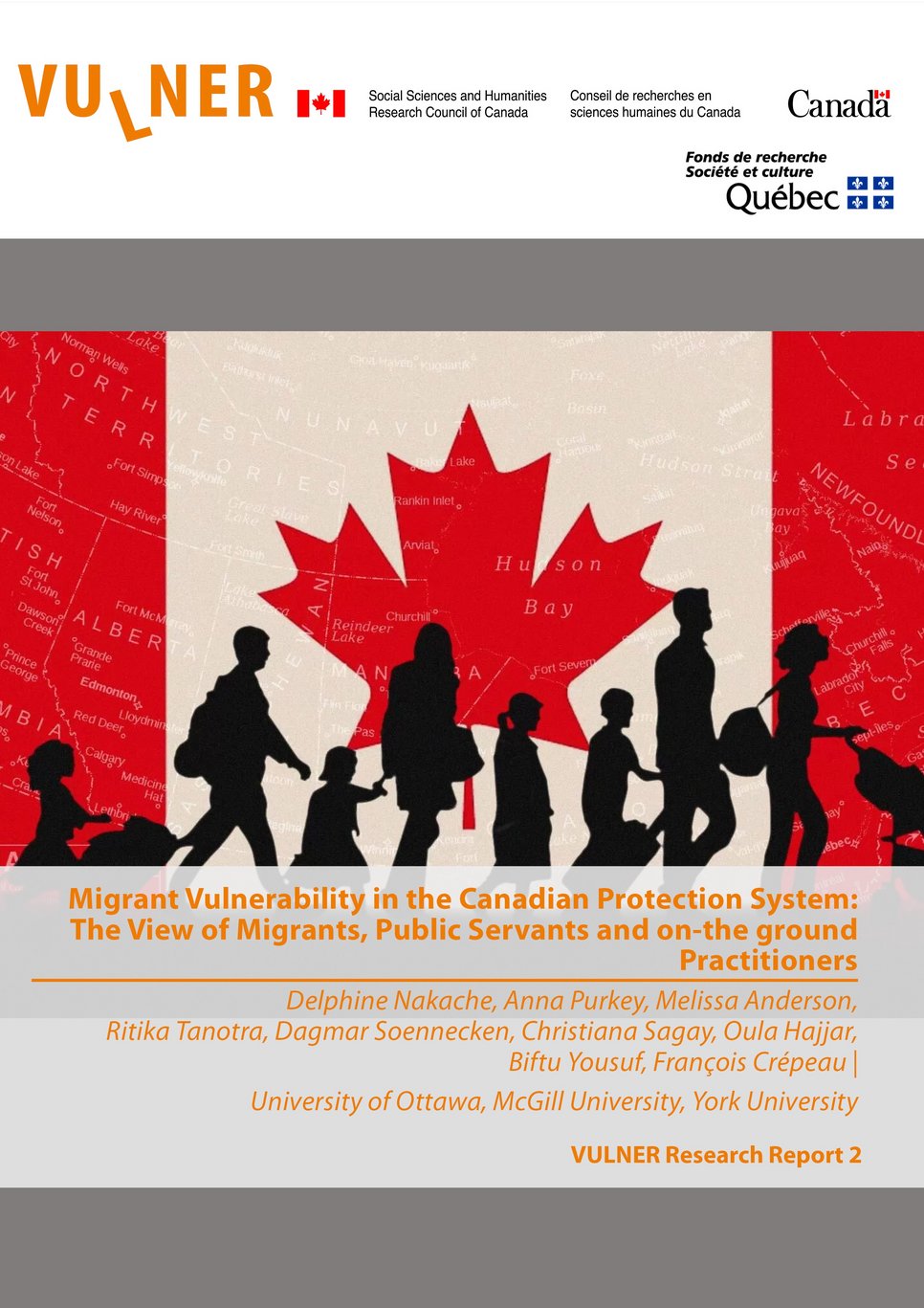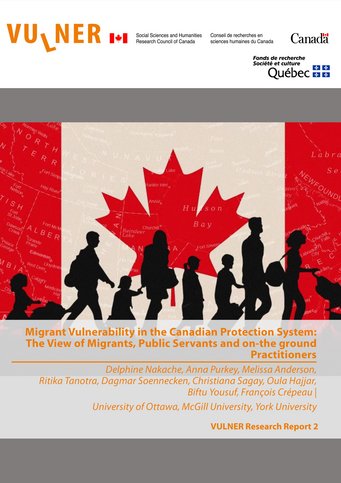Migrant Vulnerability in the Canadian Protection System: The View of Migrants, Public Servants and on-the ground Practitioners
Research report on the experiences of migrants seeking protection in Canada - by Delphine Nakache, Anna Purkey, Melissa Anderson, Ritika Tanotra, Dagmar Soennecken, Christiana Sagay, Oula Hajjar, Biftu Yousuf, François Crépeau

Throughout the VULNER project, the Canadian team seeks to answer three questions:
1. How are the ‘vulnerabilities’ of migrants defined in the relevant Canadian legislation, case law, policy documents and administrative guidelines?
2. How do Canadian decision-makers understand and address the ‘vulnerabilities’ of migrants?
3. How do the legal frameworks and the implementation practices concretely affect vulnerabilities as experienced by migrants in Canada?
Question 1 was addressed during the first phase of the project (April-December 2020), where we focused our research activities on compiling and analysing Canadian government documents and court cases pertaining to the vulnerability of migrants. These preliminary research findings were presented in our first report (VULNER Research Report 1). Questions 2 and 3 were addressed during the second phase of the project (January 2021-July 2022), where we conducted interviews with migrants and other key informants (i.e., civil servants from the federal government and ‘on the ground’ practitioners, including lawyers and NGO representatives). In this second report, we present some key results based on this second phase of the project.
The position of the Canadian team is unique in comparison to other partner countries in the VULNER project, as the second report is the first opportunity to present our findings based on interview data. Indeed, given the massive amount of documentation that we had to review in the first phase of the project, our first report only included a presentation and analysis of the desk research data. Therefore, our second report includes both an analysis of how civil servants understand and mobilize ‘vulnerability’ in their decision-making process (which was done by the other teams in their first report) and an analysis of migrants’ experiences of vulnerability. It is also worth recalling that the Canadian research covers a broad range of protection procedures:
- Refugee protection, granted to individuals who meet the strict 1951 Geneva Convention definition of a refugee, who are in circumstances considered similar to those of a Convention refugee, or whose removal to their country of origin would subject them to torture or inhumane and degrading treatment according to the Convention Against Torture (permanent residency status, with pathway to citizenship);
- Permanent residency (with pathway to citizenship), granted to individuals who are about to be removed from Canada and who demonstrate an imminent danger of torture, risk of persecution or of cruel and unusual treatment or punishment if sent back to their country of origin (Pre-Removal Risk Assessment (PRRA));
- Permanent residency (with pathway to citizenship), granted to individuals who are inadmissible or who do not meet the requirements of the immigration legislation, but have compelling Humanitarian and Compassionate (H&C) grounds to remain in Canada (Humanitarian and Compassionate Grounds (H&C));
- Permanent residency (with pathway to citizenship), granted to individuals who are inadmissible or do not meet the requirements of the existing immigration legislation, but are justified by public policy considerations to remain in Canada (Public Policy Grounds);
- Temporary protection granted to migrant workers on a valid employer-specific work permit who demonstrate experiencing abuse - or being at risk of abuse - in the context of their employment in Canada (Open Work Permit for Vulnerable Worker (OWP-V));
- Temporary protection granted to individuals recognized as victims of human trafficking or of family violence (Temporary Resident Permit (TRP)).
In addition, certain categories of migrants considered in government policies as particularly “vulnerable” - such as immigration detainees, unaccompanied minors, and undocumented migrants - are also addressed in our study.
In total, during Phase 2 of the project we conducted 104 semi-structured interviews with 110 participants. The breakdown is as follows:
- 21 interviews with 25 civil servants from the federal government (17 current employees from Immigration, Refugees and Citizenship Canada (IRCC); 6 current and 2 former employees from the Immigration and Refugee Board (IRB)).
- 55 interviews with 56 ‘on the ground’ practitioners.
- 28 interviews with 29 migrants.
Migrants’ various personal circumstances and life experiences and the complexity of the Canadian protection system - with a multiplicity of different programs, each having its own objectives, requirements, and particular clientele - result in a diversity of perspectives among our research participants and ultimately makes any generalizations challenging. However, the findings from this report reflect some common themes that emerged during our field research activities and as such, represent a first-hand, valuable source of information. Our main findings can be summarized as follows:
• Perception/understanding of vulnerability. Vulnerability is seen as an important concept in the protection system in Canada by all practitioners and civil servant interviewees, but the specific understanding or interpretation of this concept varies widely. For migrant participants, their views and understandings of “vulnerability’ also vary greatly: some migrants do not understand the word “vulnerability” and its related notions, while others have a very articulated understanding of vulnerability. Also, some migrant participants do not view themselves as “vulnerable” while others do. Interestingly, when we asked our migrant participants if they felt that they were “more” vulnerable than other groups of migrants, most of them answered that they cannot speak for the others: that their perception of vulnerability is only linked to their own/individual experience of migration. However, most migrants indicated that having ones’ immigration status in limbo is a great source
of vulnerability.
• How vulnerability is addressed and accommodated within the claims for protection, according to civil servants and practitioners. Civil servants were asked how vulnerability impacts both the procedures and outcomes of the decision-making process and their answers varied significantly depending upon the program line in question. Broadly speaking, the recognized vulnerabilities of migrants seem to be a substantive factor in the outcome of decisions in the context of the following applications: humanitarian and compassionate (H&C) claims, open-work permits for vulnerable worker (O-WPVW), temporary resident permits (TRP) and overseas resettlement applications. This can be contrasted with the narrower approach adopted for in-Canada asylum claims, where the impact of vulnerability is primarily procedural. The flexibility that decision makers have in accommodating vulnerabilities during the in-Canada process is a source of frustration for legal professionals seeking procedural accommodations for their clients, especially since securing a psychological report (as support for a request for accommodation) is particularly difficult. These legal professionals also shared concerns around the role of Immigration and Refugee Board (IRB) Members in making a medical assessment beyond their legal expertise.
• Key factors of vulnerability in migrants’ lives. Overall, participants’ responses indicate that immigration status and health (both mental health and physical health) act as intersecting factors of vulnerability in migrants’ lives. At a personal level, our migrant participants also identified family as a factor that can either reduce or exacerbate vulnerability. With respect to migrants’ interactions with various key stakeholders, unscrupulous lawyers/ immigration consultants and long delays in immigration proceedings were reported as creating or exacerbating migrant vulnerabilities. The uncertainty created by the exercise of broad discretionary powers by decision makers, especially in certain applications for protection (such as H&C, TRP and OWP-V applications), were also seen as sources of migrant vulnerability. At the policy level, quotas and target numbers imposed by government policymakers were identified as negatively impacting migrant vulnerabilities. A related concern that was raised pertained to the limited availability of external recourse for migrants faced with a negative decision. Finally, the absence of measures allowing for the appointment of designated representatives in IRCC or Canadian Border Services Agency proceedings, and the lack of settlement and free legal services for migrant workers, were identified by interviewees as increasing migrant vulnerabilities.
Download the full report here.
